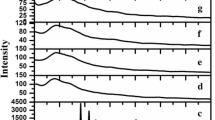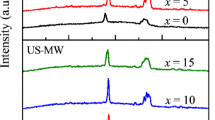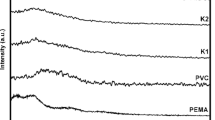Abstract
In the present work, five systems of samples have been prepared by the solution casting technique. These are the plasticized poly(methyl methacrylate) (PMMA-EC) system, the LiCF3SO3 salted-poly(methyl methacrylate) (PMMA-LiCF3SO3) system, the LiBF4 salted-poly(methyl methacrylate) (PMMA-LiBF4) system, the LiCF3SO3 salted-poly(methyl methacrylate) containing a fixed amount of plasticizer ([PMMA-EC]-LiCF3SO3) system, and the LiBF4 salted-poly(methyl methacrylate) containing a fixed amount of plasticizer ([PMMA-EC]-LiBF4) system. The conductivities of the films from each system are characterized by impedance spectroscopy. The room temperature conductivity in the pure PMMA sample and (PMMA-EC) system is 8.57 × 10−13 and 2.71 × 10−11 S cm−1, respectively. The room conductivity for the highest conducting sample in the (PMMA-LiCF3SO3), (PMMA-LiBF4), ([PMMA-EC]-LiCF3SO3), and ([PMMA-EC]-LiBF4) systems is 3.97 × 10−6, 3.66 × 10−7, 3.40 × 10−5, and 4.07 × 10−7 S cm−1, respectively. The increase in conductivity is due to the increase in number of mobile ions, and decrease in conductivity is attributed to ion association. The increase and decrease in the number of ions can be implied from the dielectric constant, ɛr-frequency plots. The conductivity–temperature studies are carried out in the temperature range between 303 and 373 K. The results show that the conductivity is increased when the temperature is increased and obeys Arrhenius rule. The plots of loss tangent against temperature at a fixed frequency have showed a peak at 333 K for the ([PMMA-EC]-LiBF4) system and a peak at 363 K for the ([PMM-EC]-LiCF3SO3) system. This peak could be attributed to β-relaxation, as the measurements were not carried out up to glass transition temperature, T g. It may be inferred that the plasticizer EC has dissociated more LiCF3SO3 than LiBF4 and shifted the loss tangent peak to a higher temperature.







Similar content being viewed by others
References
Chung SH, Heitjans P, Winter R, Bzaucha W, Florjanczyk Z, Onoda Y (1998) Solid State Ion 112:153–159
Nagasubramanian G, Attia AI, Halpert G (1994) J Appl Electrochem 24:298
Tallworth PE, Greenbaum SG, Croce F, Slane S, Salomon M (1995) Electrochim Acta 40:2137
Morales E, Acosta JL (1997) Solid State Ion 96:99
Abbrent S, Lindgren J, Tegenfeldt J, Wendsjo A (1998) Electrochim Acta 43:1185
Kakihana M, Schantz S, Torell LM (1990) J Chem Phys 92:6271
Bernson A, Lindgren J (1993) Solid State Ionics 60:37
Wintersgill MC, Fontanella JJ (1989) Polymer Electrolytes Reviews 2. Elsevier, London
Ross J, MacDonald (1987) Impedance spectroscopy. Wiley, USA
Van Gool W, Hagenmuller P (eds) (1978) Solid electrolytes general principles, characterization, materials, applications, materials science and technology. Academic, USA
Julien C, Gholam-Abbas N (1994) Solid state batteries: materials design and optimization. Kluwer, London
Souquet JL, Levy M, Duclot M (1994) Solid State Ion 70/71:337–345
Ramesh S, Arof AK (2001) Mat Sci Eng B85:11
Michael MS, Jacob MME, Prabaharan SRS, Radhakrishna S (1997) Solid State Ionics 98:167
Davis WJ, Pethrick RA (1998) Polymer 39(2):225
Author information
Authors and Affiliations
Corresponding author
Rights and permissions
About this article
Cite this article
Othman, L., Chew, K.W. & Osman, Z. Impedance spectroscopy studies of poly (methyl methacrylate)-lithium salts polymer electrolyte systems. Ionics 13, 337–342 (2007). https://doi.org/10.1007/s11581-007-0120-0
Received:
Accepted:
Published:
Issue Date:
DOI: https://doi.org/10.1007/s11581-007-0120-0




